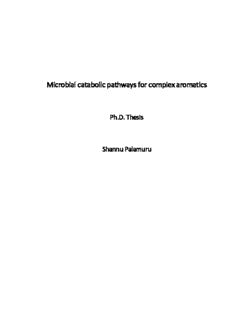
Microbial catabolic pathways for complex aromatics PDF
Preview Microbial catabolic pathways for complex aromatics
Microbial catabolic pathways for complex aromatics Ph.D. Thesis Shannu Palamuru This thesis is dedicated to my parents Malan Bee and Ramulu and my wife Keerthi For their endless love, support and encouragement A thesis submitted for the degree of Doctor of Philosophy of The Australian National University Microbial catabolic pathways for complex aromatics Shannu Palamuru Research School of Chemistry, Australian National University Canberra, Australia and Commonwealth Scientific and Industrial Research Organization Land and Water flagship Canberra, Australia October 2015 Declaration I Shannu Palamuru hereby declare that this submission is my own work and that, to the best of my knowledge and belief, it contains no material previously published or written by another person nor material which to a substantial extent has been accepted for the award of any other degree or diploma at the Australian National University or any other educational institution, except where due acknowledgement is made in the thesis. Name: Shannu Palamuru Sign: Date: 21.10.2015 I Acknowledgments First and foremost I would like to thank my wonderful parents, wife, brothers and friends for supporting me through my university years. It is a pleasure for me to express my particular gratitude to my supervisor Dr John Oakeshott for his guidance and encouragement throughout my PhD studies. Without his guidance and support this dissertation would not have been possible. He has also looked out for me more broadly through my time in Canberra. I am also very grateful to my other CSIRO supervisor Dr Gunjan Pandey, and Prof. Jim Spain of Georgia Institute of Technology, for all their support and guidance. Likewise my ANU supervisor Professor Chris Easton for all his input, particularly in respect of the reaction chemistry of my enzymes. Additionally I thank Dr Nikki Dellas (CSIRO) for all her advice and practical assistance in my lignin dehydrogenase work. Specifically she cloned and purified some of the dehydrogenases (2550, 1498, 2705, 3344, 474, and 724) from the SG61-1L bacterium and led the phylogenetic analysis of the dehydrogenases. I am most grateful to Dr Tekle Tafese Fida and Professor Jim Spain (Georgia Institute of Technology) who provided me with the 2,4-dinitroanisole degrading bacterium Nocardioides sp. strain JS1661 that they had previously isolated and who carried out the growth and cell free extract experiments on this bacterium. I am also most grateful to: Professor Eiji Masai (Nagaoka University of Technology, Japan) for providing the guaiacylglycerol-β-guaiacyl ether (GGE) stereoisomers and the Sphingomonas paucimobilis SYK-6 bacterium; Dr Andrew Warden (CSIRO) for helpful discussions and the NMR analysis of GGE compounds; Dr II Jian-Wei Liu and Dr Chris Coppin (CSIRO) for technical advice throughout my PhD; Dr Matt Taylor for assistance with analytical techniques; Dr Lars Jermiin (CSIRO) for assistance with the generation of protein sequence alignments and phylogenetic tree construction; Dr Peter Campbell (CSIRO) for assistance with tryptic digestion and protein identification; Stuart Kewish and Catherine Reid at the Australian Paper Mill for providing sewage samples; Dr Jung-Woo Park (Australian National University) for the IC- PMS analysis of metal in the DNAN O-demethylase enzyme; Dr Stephen Pearce for assisting with bioinformatics; and Alison Scott for supporting me with ANU administration. I have also found many fantastic colleagues and friends at CSIRO and wish to thank them for their friendship here. I particularly acknowledge Robyn Russell, Peter Hart, Sue Dorrian, Chris Coppin, Jian-Wei Liu, Ree Murnane and Eva Zinkovsky. III List of Abbreviations ABTS = 2,2′-Azinobis-(3-ethylbenzthiazoline-6-sulfonate) ACN = Acetonitrile ADH = Alcohol dehydrogenase AMS = Ammonium sulphate ANAN = 2-Amino-4-nitroanisole ANU = Australian National University BCA = Bicinchoninic acid assay BSA = Bovine Serum Albumin BTEX = Benzene, toluene, ethylbenzene and xylene ChE = Cholinesterase DMSO = Dimethylsulfoxide DNA = Deoxyribonucleic acid DNAN = 2,4-Dinitroanisole dnH1 = DNAN hydrolase α-subunit dnH2 = DNAN hydrolase β-subunit DNP = 2,4-Dinitrophenol EDTA = Ethylenediaminetetraacetic acid FAD = Flavin adenine dinucleotide FPLC = Fast protein liquid chromatography IV GGE = Guaiacylglycerol-β-guaiacyl Ether GH = Glycoside hydrolase GS-HPV = α-Glutathionyl-β-hydroxypropiovanillone GST = Glutathione S-transferases HAA = 3-Hyroxyanthranilic acid HBT = 1-Hydroxybenzotriazole HEPES = 2 -[4-(2-hydroxyethyl)piperazin-1-yl] Ethanesulfonic acid HLADH = Horse liver alcohol dehydrogenase HMX = Cyclotetramethylenetetranitramine HNB = Hexanitrostilbene HPLC = High pressure liquid chromatography HPV = Hydroxypropiovanillone ICP-MS = Inductively coupled plasma mass spectrometry IPA = Isopropylamine IPTG = Isopropyl β-D-1-thiogalactopyranoside k = Turnover number cat k /K = Catalytic efficiency cat M kDa = Kilo Dalton K = Michaelis constant M LB = Luria Bertani V LC/MS = Liquid chromatography/mass spectrometry LiP = Lignin peroxidase M/Z = Molecular Ion MeOH = Methanol MM = Minimal Medium MMA = 4-Methoxymandelic Acid MnP = Manganese peroxidases MPHPV = α-(2-methoxyphenoxy)-β-Hydroxypropiovanillone NA = Nutrient agar NAC = Nitroaromatic compounds NAD = Nicotinamide adenine dinucleotide NADP = Nicotinamide adenine dinucleotide phosphate NB = Nutrient broth NMR = Nuclear magnetic resonance OD = Optical density at 600 nm 600 ORF = Open reading frame PAH = Polyaromatic hydrocarbons PCR = Polymerase chain reaction PDB = Protein data bank PMSF = Phenyl methane sulfonyl fluoride VI POP = Persistent organic pollutant PVDF = Polyvinylidene fluoride RAST = Rapid Annotation using Subsystem Technology RDX = Cyclotrimethylenetrinitramine RT = Retention time SADH = Saccharomyces cerevisiae alcohol dehydrogenase SDR = Short-chain alcohol dehydrogenases/reductases SDS-PAGE = Sodium dodecyl sulphate polyacrylamide gel electrophoresis SEC = Size exclusion chromatography TFA = Trifluoroacetic acid THF = Tetrahydrofolate TNT = 2,4,6-trinitrotoluene TOF = Agilent 1200 Infinity Series Time Of Flight TSB = Trypticase soy broth VA = Veratryl alcohol Ni-NTA = Nickel-nitrilotriacetic acid VII
Description: